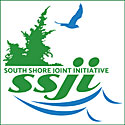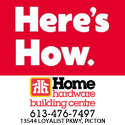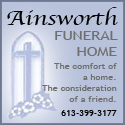Council hears review of 10-year parks and recreation master plan
Administrator | May 31, 2025 | Comments 3
 By Sharon Harrison
By Sharon Harrison
The finalized version of the County’s parks and recreation master plan was presented to council (nine of 14 in attendance) at Thursday’s committee of the whole meeting.
Sierra Planning and Management (SPM) was the consultancy firm instructed to undertake the task of reviewing the County’s parks and recreational facilities and amenities, a process involving five phases which began in late 2022.
Jonathan Hack, a director with SPM, in his lengthy and detailed presentation, provided the overall scope, explaining the framework for the plan and how it constitutes guidelines to accommodate growth and change, based on an agreed level of service. While a long time in making, he declared “It’s going to be a good plan”.
Broad in scope, the plan is a high-level, 10-year window he said, and deals with everything in terms of community facilities (indoor), the new and the old, the heritage and yet-to-be-built, as well as all the outdoor facilities. The master plan covers municipal assets, or assets owned by community organizations.
“What we are not talking about is all the other stuff that the County is well known for, the tourism in general, access to the water through lands which are not your own,” said Hack. “All of that stuff is very relevant, and all the consultation we’ve done reflects that, and obviously the plan itself needs to tie in with all the broader plans that you have, to continue to be a destination of choice for day-trippers, weekenders, and lots of other people.”
He said, the plan doesn’t direct community growth, but it responds to it.
“If you’ve got population projections, if there are discussions around growth management, this is one of the plans that needs to be instructed as a result of that. If you are growing faster, some of the provisions in this plan would need to happen sooner; if you are growing slower, then it means the implementation plan can be pushed back.”
The scope of the plan includes the areas of service delivery, indoor facilities, outdoor facilities, and parks and trails, and consisted of consultations, assessment and inventory, community engagement, establishing key strategic direction and objectives, culminating in developing options and recommendations.
The framework of the master plan looked at three pillars: community recreation hubs, service delivery excellence, and parks and outdoor facilities.
Service delivery – This includes buildings and parks where services happen; either the County provide the services, or the community or the volunteer base provides the services, or people provides it themselves (unstructured recreation).
“The aim here is to deliver effective recreational services, which may include improving service delivery through partnerships, creating vibrant museum experiences, and establishing appropriate levels of subsidization,” explained Hack.
Service delivery includes a whole range of things he said, some of which are yet to be done.
“What is the appropriate level of subsidization that you should be providing for the facilities? And this goes to issues of cost recovery; we want to understand where the balance should be in terms of user fees versus tax support.”
Parks and outdoor facilities – Outdoor facilities incorporate playgrounds, skate parks and splash pads, ball diamonds and rectangular fields, outdoor ice rinks, horse rings, multi-use courts, and boat launches and beaches.
This focuses on strategic investment in outdoor facilities. Also, actively planning new parkland, strengthening the trail network, considering new and emerging facilities, and right-sizing the parkland portfolio.
“Making sure access to parkland and open space is critical, particularly as you have new sub-divisions coming on-stream,” he explained. “There is a traditional approach, which is provision of parkland as an afterthought, that one lot at the end of a cul-de-sac that represents the five percent you have to give as dedication, or there is a better approach, which is plan-driven.”
Indoor facilities – Indoor facilities include things like stand-alone town halls, museums, the Crystal Palace, community centres and indoor ice facilities.
“Your cost recovery on your rinks is woeful, that’s just the fact of it,” stated Hack. “That’s not to say you don’t continue that, and there may be a policy decision, but it’s this kind of document that gives you the authority and the weight of information behind you to make a decision. Either you pivot or you remain as-is, but you do so with good information.”
Of the six community workshops held over a one-year period, around 180 people attended. Further, a public online survey garnered 681 responses, with a user group online survey receiving 46 responses from stakeholder groups. Subsequent and continuous outreach to external stakeholders resulted in six interviews undertaken with groups such as the South Shore Joint Initiative, Ontario Parks, the local school board, Quinte Conservation and the Prince Edward Fitness and Aquatic Centre.
The overall framework of the plan is to develop pillars explained Hack, and because the County is so large [geographically], he said the approach had to ensure it was not centralized just on the larger centres of Picton and Wellington.

“We wanted to do that without also walking into the issue of essentially doing a plan and trying to create equity between the wards, because that is also not an appropriate way to plan,” explained Hack. What we ended up having was designating recreation hubs so that we meet the needs of everyone in the County, so the provisions of this plan speak to your needs.”
Community recreation hubs – This looked at designating hubs for recreation, pro-active planning for indoor facilities, and recognizing the importance of the assets.
He explained how the community recreation hubs are broken down, with the primary hubs of Picton and Wellington catering to the largest population centres, have major indoor facilities (arenas and rinks), along with a variety of parks and outdoor facilities (ball diamonds and tournament centres).
Secondary hubs include the smaller centres (indoor and outdoor) to include villages and town centres of Ameliasburgh, Hillier, Waupoos, Milford, Demorestville, Bloomfield and Cherry Valley.
These secondary hubs have smaller indoor facilities, such as town halls, with parks and outdoor facilities (often adjacent to town halls), and will provide a limited variety of amenities.
Outdoor hubs are centred on the villages and town centres of Northport, Prinyer’s Cove, Rossmore, Consecon and Carrying Place and will provide parks and outdoor facilities as a focal point, but with a limited variety of amenities.
“This is a recognition that there are activity centres which are of an outdoor nature, so they’re not where you are going to have big facilities, and they located where there are existing parks, centralized playgrounds, amenities, infrastructure of an outside nature.”
Hack said they are not trying to penalize communities within the County that have types of indoor facilities that are older, such as the old school house in Hillier, as an example.
“They still have a value, and so we are not in the business of developing this as the basis for disinvestment, it is the opposite. So, how do you invest on an appropriate scale with all the things that you might have to do as you accommodate a changing population over time.”
Looking at the strategic direction of the plan, Hack outlined the recommendation of designating hubs for recreation, offering three main objectives:
Optimizing use of existing assets – Focus planning for indoor facilities in the two existing primary hubs, and maximize year-round utilization of indoor facilities, including arenas.
Support a hierarchy for recreational hubs – Develop a clear program and service delivery expectation for each town hall.
Develop master plans for key hubs – Picton fairgrounds, Wellington ballpark, and Roblin Lake park as important hubs.
It’s not always about building new, said Hack.
“Building new is very expensive, so it is about optimizing use of existing assets, so planning for indoor facilities in those two hubs [Picton and Wellington].”
He said the Wellington and District Community Centre was a really good example of a modern build, and the facility and the nearby ball diamond complex as being a fundamental hub and an area that could possibly be expanded.
The arena in Picton and the fairgrounds all needs a certain degree of TLC, said Hack, where he spoke to state of good repair, capital investments and maintaining those assets.
He said there is support for program development and services appropriate to the individual hubs, noting there are certain lands that warrant further investigation.
He used Roblin Lake as an example, which has access to water, an older community hall that functions well, and a public works yard (with challenges from a risk management perspective). There is a certain amount of design work that is the next obvious stage to say what are we going to do to improve the organization, including the heritage village, explained Hack.
Importance of assets
When it comes to recognizing the importance of the assets, two key objectives were highlighted:
Maintaining existing assets – Ensuring key facilities are being managed with the best interest of the community in mind, and programmed effectively; and
Ensure active involvement in facility economics and allocations – Key recommendations include developing a renewed ice allocation policy, and increase County awareness of the use and operating financials of town halls.
“The town halls are fine. There are a few things we would obviously want to see changed to some levels of utilization, some capital works to be done, but it’s more about just having greater oversight of how you are using those facilities,” he explained. “We not proposing to remove them, but they are municipal assets and we need to know over the next 10 years what are you going to be doing with them.”
Speaking to management, he addressed what level of municipal oversight could be without getting in the way of the work of individual recreation associations and utilizing spaces effectively.
Pro-active planning
Pro-active planning for indoor facilities includes objectives for protecting land for future use, and to plan for a municipal pool and gymnasium, as follows:
Protecting land for future use – Recommendation is to protect the land at the Wellington and District Community Centre for future facility expansion to create a multi-use community recreation centre; and
Plan for a municipal pool and gymnasium – The short-term recommendation is to continue to support the Prince Edward Fitness and Aquatic Centre (PEFAC) to maintain community use of the pool. The long-term recommendation is to begin to plan to develop a municipal aquatic facility and gymnasium, as part of a multi-use community recreation centre.
“At some point in the future, there may be an opportunity to add an ice pad, the location for that would be at the Wellington and District Community Centre,” shared Hack. “The issue there is can you squeeze it on (probably not), can you protect land for future development – that would be the appropriate position to take:”
Hack said the County must plan for a municipal pool and gym.
For the $70,000-$80,000 the County provides PEFAC for the community to use a 25-metre pool, Hack said that would be about a tenth of the cost if the County ran its own pool in operational terms.
“In the long-term, as the population gets to a certain total, the opportunity for having an indoor aquatic centre is going to rise up, so we are putting it out there to start to socialize the concept,” he said.
Right now, it’s about maintaining what’s existing he said, and recognizing that there are elements of community that will go to Belleville, for example.
“Now is not the time to respond to those in the community that might be saying, we must build a pool. I don’t think you have to, but you have to recognize that if you were going to build a gymnasium for example, which I think is a good municipal addition to any one of your rink facilities, because that allows you to really program effectively. Not cheap, but it is a project you could really wrap around.”
Speaking on behalf of the Prince Edward Fitness and Aquatic Centre, Sue Mathieu, secretary to the board of directors, spoke to PEFACs role in the parks and recreation master plan. She outlined a little of the history and future goals, noting PEFAC has provided a pool and a full range of aquatic programs and fitness facilities to the local community for close to 20 years, supported by the County.
PEFAC is the only publicly available indoor pool in Prince Edward County, and operates as a not-for-profit organization. It currently enjoys the highest membership levels in its history having seen a rebound and significant increase in usage since Covid, with 1,250 individual members, and with over 2,000 day passes sold in the past year.
Mathieu addressed the master plan’s long-term planning process regarding an aquatic facility, noting how PEFAC have also adopted a long-term vision statement.
“We have embarked on a long-range planning effort on what the potential is at our current location… to consider opportunities for an additional and/or new pool, a gymnasium, enhanced accessibility and potentially some other community space, such as child care programs, and a re-configuration of our parking lot – where options include looking at the ownership of the property.“
Delivering effective recreational services
An appropriate role needs to be established for the County, where the recommendation is to move to provide more programs directly, and/or support community groups, as well as develop and prioritize County programs. Hack also touched on the importance of maintaining volunteerism.
As the role as a program provider develops over time, the County will need to consider gaining greater access to existing facilities, staffing resources, and balance between direct programming and community development.
“What is the appropriate role for the County in terms of provision of extra services? What we heard from people was they do want a broader range of programs. Having indoor facilities that have a multi-purpose is important and there is always a role for increasing staff resources.”
He said, the reality is, as population grows, there is going to be a need for bolstering community services and that usually comes with a requirement for stability in maintaining staffing capabilities.
Establishing appropriate levels of subsidization
It is important to ensure appropriate levels of subsidization and that came with a recommendation for a comprehensive user fee study/subsidization policy, as well as monitor and utilize non-municipal funding sources, and making time to source government grants.
“It is really important: it’s a balance between fees and tax support,” outlined Hack. “The way you do that is you just go through a small exercise which addresses where the cost recovery should be relative to your peers in south-eastern Ontario, but then get to the specifics of the history.”
Improving service delivery through partnerships
The idea here is to leverage investment in recreation with partnerships to continue to provide the required services to residents and visitors, also, community access to school gymnasiums.
Create vibrant museum experiences
Ensure effective delivery of County museums came with the recommendation of undertaking a service delivery review, explore partnerships with corporate commercial sector, and engage with the regional museum to provide joint and/or complementary programs and exhibits, as well as enhancing outdoor experiences at museums.
“These are assets that you need to make sure are covered off in this plan, don’t let them fall between the cracks. Even the pioneer spaces and buildings, keep a focus on that.“
Strategic investment in outdoor facilities
Focus major investment at recreation hubs and consider developing amenities at destination or community scale parks, such as an outdoor pool, splash pad, and pump track/all-wheel facility.
Plan for unique neighbourhood opportunities and develop a playground replacement strategy, evaluate opportunities for active sport facilities at a local scale, and monitor usage and assess potential to re-purpose under-used local facilities.
Consider new and emerging facilities and keep pace with new sports and trends by developing a municipal service policy, and prioritize community-based proposals for new and emerging facilities.
Hack also spoke to actively planning new parkland where he recommended standardizing park planning and design and creating a parks design standardize manual.
Retaining and enhancing waterfront lands came with the recommendation of enhancing unopened road allowances, increase awareness of public access points, and strategic review of boat launches.
Speaking to under-used parkland, Hack spoke to right-sizing where the recommendation is to evaluate under-used parkland against future recreation needs of the community, and consider naturalization to reduce maintenance requirements. This included enhanced unopened road allowances to increase the opportunities for access.
Public access points and a review of boat launches were also suggested, along with de-commissioning parkland.
“Are there any remnant parcels, are there any tiny lots that you are just going and mowing them and nobody is using,” said Hack. “At the other end of the scale, is there opportunity with the assets that you have linear corridors, or whatever it might be, to allow members of the public or tourists to be able to see the wild side of the County, because the geology here is stunning and there is all this very significant potential. How can you develop that without increasing your operating costs.”
Addressing strengthening the trail network included standardizing and developing trail connections with the recommendation to encourage the development of trails within new developments, and create a trail design standards manual.
The parks and recreation master plan is to go to council for ratification at the June 10 council meeting. The plan is expected to be published at the end of June after staff input, at which time there is to be opportunity for further community engagement. It will come back to be finally finalized to include more levels of detail along with capital costing, in time for budget deliberations.
Parks and recreation future: ‘you can’t do everything for everyone’
Filed Under: Featured Articles • Local News
About the Author:


































I suppose the best person to answer the question of consultancy cost would be the Director of Finance and IT/Treasurer. Should be under the “Contact Us” section on Shire Hall’s website.
And whom would have the experience and knowledge in house to undertake this review?
Another consultant firm! Wondering what this study cost. It seems like a no-brainer! Can the County not appoint a “committee” to undertake this study? Like to know what our County spends on Consultants.In my opinion only…Wasted dollars!